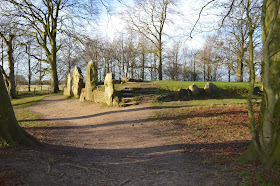In this blog I have previously mentioned the Oxfordshire village of Uffington as the home of the Uffington
White Horse, which is thought to be the oldest white horse in Britain. It was not until I recently visited Uffington however that I became aware of some of the other wonders that the local landscape has to offer.
The white horse lives next to Uffington Castle.
Uffington Castle is an Iron Age bank and ditch style
hill fort which encloses around 8 acres of land and commands extensive views over the local countryside, as can be seen in the below photos.
 |
| Uffington Castle's earthworks. |
 |
| Uffington Castle's earthworks and extensive views. |
 |
| Information board. |
Directly below the white horse is a small chalk hillock that has a seemingly artificial flat top. This hillock is known as Dragon Hill. This hill is linked to the legend of King George and the dragon. The legend claims that the summit of the hill is where Saint George slew the dragon, and that the bare patch of chalk that can be seen is where the dragon’s blood spilled (and hence no grass will now grow there).
It has also been suggested that
Dragon Hill may have been used for Iron Age rituals that were associated with the white horse.
 |
| Looking from above the horses' head down towards Dragon Hill. |
 |
| Dragon Hill. |
 |
| Looking back up towards the white horse from Dragon Hill. |
The other local feature, that is about a mile walk along the
Ridgeway from Uffington Castle, is the Neolithic long barrow which is known as Wayland’s Smithy.
This tomb dates from around 3700 BC and is about 56m long by 13m wide. When the tomb was excavated in the 1960’s it was found to contain the remains of 14 people, who seem to have been de-fleshed before burial.
The name of the tomb derives from its association by the Saxons with the Germanic god Wayland (also known as Wolund) who was a smith. The Saxons began to live in the area around 4000 years after the tomb was built and the Saxon association of the tomb with Wayland the Smith gave rise to an interesting legend. Apparently if a traveller had a horse that had lost a shoe, leaving the horse and a silver coin (as payment) at the tomb overnight would result in the horse being re-shod by morning.
 |
| Information board. |
 |
| Side view of the long barrow. |
 |
| Front view of the long barrow. |
 |
| The entrance. |
 |
| Looking from the back to the front of the long barrow. |
Even though the long barrow of
Wayland’s Smithy is around 5700 years old it seems that practice of using long barrows as tombs has not died out entirely. The village of All Cannings, near Devizes in Wiltshire, will soon be home to a new long barrow which is currently under construction. Once completed, paying customers will be able to book their place in eternity in the long barrow - a method of burial that was once reserved only for the social elite of ancient Britain (December 2013
news article, January 2014
news article).
Pictures, Oxfordshire (December 2013).
If you find this post interesting please share it using the buttons below.











No comments:
Post a Comment